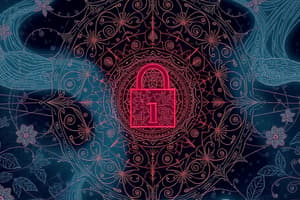Podcast
Questions and Answers
What is another name for hackers?
What is another name for hackers?
illegally break into a computer or network.
Viruses that load from USB drives left connected to computers when computers are turned on are known as:
Viruses that load from USB drives left connected to computers when computers are turned on are known as:
- Encryption viruses
- Script viruses
- Polymorphic viruses
- Boot-sector viruses (correct)
Why is a packet analyzer called a sniffer?
Why is a packet analyzer called a sniffer?
- It starts a denial-of-service attack
- It detects high-speed transmissions
- It captures and reads data inside each packet (correct)
- It filters out spam
Ransomware as a Service has allowed the increase of:
Ransomware as a Service has allowed the increase of:
A ______ is a program that takes complete control of your computer without your knowledge.
A ______ is a program that takes complete control of your computer without your knowledge.
Multifactor authentication requires you to have a combination of:
Multifactor authentication requires you to have a combination of:
Authentication techniques that rely on personal biological traits are called:
Authentication techniques that rely on personal biological traits are called:
Antivirus software prevents infection by recording key attributes about your files and checking to see if they change over time in a process called:
Antivirus software prevents infection by recording key attributes about your files and checking to see if they change over time in a process called:
What can a surge protector do?
What can a surge protector do?
Firewalls use a process of _____________ to assign IP addresses to the devices internal to the network.
Firewalls use a process of _____________ to assign IP addresses to the devices internal to the network.
The logical port of your computer is always port 8000.
The logical port of your computer is always port 8000.
Your social security number should never be shared on a website, in an email, or through messaging.
Your social security number should never be shared on a website, in an email, or through messaging.
Sending e-mails to lure people into revealing personal information is a technique known as phishing.
Sending e-mails to lure people into revealing personal information is a technique known as phishing.
Encrypting data is not an appropriate measure for mobile devices such as smartphones.
Encrypting data is not an appropriate measure for mobile devices such as smartphones.
Virtual private networks make it just as secure to send information across a public network as it is on a secure private network.
Virtual private networks make it just as secure to send information across a public network as it is on a secure private network.
Flashcards are hidden until you start studying
Study Notes
Cybersecurity Concepts
- Hackers: Individuals who illegally breach computer systems and networks, often for malicious purposes.
- Boot-sector viruses: Types of malware that infect the boot sector of USB drives, executing upon system startup.
Network Security Tools and Techniques
- Packet Analyzer (Sniffer): A tool that captures and analyzes data packets as they traverse a network, helping in troubleshooting and monitoring.
- Ransomware as a Service (RaaS): A model that has led to an increase in ransomware attacks by enabling even non-technical users to launch such attacks.
Malicious Software
- Rootkit: A type of malicious software that gives unauthorized users complete control of a computer without detection.
- Inoculation in Antivirus Software: A preventative method where antivirus programs record file attributes to monitor for changes and potential infections.
Authentication and Protection Measures
- Multifactor Authentication: Security protocol that requires verification through a combination of something known (password), something inherent (biometrics), and something owned (security token).
- Biometrics: Authentication methods that use personal biological traits like fingerprints or facial recognition for security.
Device Protection
- Surge Protectors: Devices designed to protect electronic equipment from voltage spikes, ensuring device longevity and preventing damage.
- Network Address Translation (NAT): A firewall technique that assigns internal IP addresses to devices, obscuring them from external threats.
Security Best Practices
- Sharing Personal Information: It is unsafe to share sensitive information like social security numbers online or via email.
- Phishing: A fraudulent technique that involves sending deceptive emails to trick users into divulging personal data.
Misconceptions and Truths
- Port Assignments: It is incorrect to assume that the logical port of a computer is always port 8000; port numbers vary based on application and setting.
- Data Encryption on Mobile Devices: Encrypting data on smartphones is critical for security and protecting personal information.
- VPN Security: Utilization of Virtual Private Networks (VPNs) can make sending information over public networks as secure as private ones.
Studying That Suits You
Use AI to generate personalized quizzes and flashcards to suit your learning preferences.




